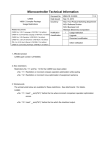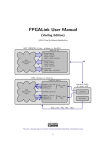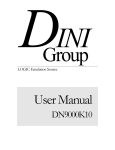Download 4 - Downloads
Transcript
User’s Manual
Version 1.0.3
December 7, 2004
Atmark Techno, Inc.
http://www.atmark-techno.com
User’s Manual 1.0.2
Table of Contents
1. Introduction................................................................................................................................................. 1
2. Precautions ................................................................................................................................................ 2
2.1.Safety Precautions................................................................................................................................ 2
2.2. Handling Precautions........................................................................................................................... 2
3. Features ..................................................................................................................................................... 4
4. Before Getting Started................................................................................................................................ 5
4.1. Part Names of the JTAG-Blazer........................................................................................................... 5
4.2. Part Names of JB Manager.................................................................................................................. 7
4.3. Installing JB Manager .......................................................................................................................... 8
4.4. JTAG-Blazer Connection Diagram ....................................................................................................... 8
4.5. Connecting a JTAG Cable ................................................................................................................... 8
4.6. Networking........................................................................................................................................... 9
5. How to Use the JTAG-Blazer.................................................................................................................... 10
5.1. Searching/Setting IP Address .............................................................................................................11
5.2. Writing to Target................................................................................................................................. 15
5.3. Writing to Internal Memory................................................................................................................. 18
5.4. Writing in Standalone ......................................................................................................................... 21
5.5. Displaying Configuration Information ................................................................................................. 22
5.6. Displaying Internal Memory Information............................................................................................. 25
5.7. Setting the JTAG Clock...................................................................................................................... 27
5.8. Displaying Firmware Information ....................................................................................................... 29
5.9. Upgrading Firmware .......................................................................................................................... 30
5.10. Clearing History ............................................................................................................................... 32
5.11. TE7720 Device Mode....................................................................................................................... 33
6. Troubleshooting........................................................................................................................................ 34
Appendix
Appendix A. Product Specifications .............................................................................................................. 35
Appendix B. Creating a XSVF File with iMPACT .......................................................................................... 37
Appendix C. Error List .................................................................................................................................. 47
Appendix D. Illumination Pattern of ERR Lamp............................................................................................ 48
Appendix E. JTAG Connector Pin Assignment ............................................................................................. 49
Appendix F. List of Connectors for JTAG Cables.......................................................................................... 50
Appendix G. Precautions for Target Board Design ....................................................................................... 51
Appendix H. JB Manager for Linux............................................................................................................... 52
Revision History ........................................................................................................................................... 55
Warranty Services ........................................................................................................................................ 56
i
User’s Manual 1.0.2
List of Figures
Figure 4-1 External View of the JTAG-Blazer.......................................................................................... 5
Figure 4-3 JB Manager Main Screen ...................................................................................................... 7
Figure 4-5 Connection Diagram .............................................................................................................. 8
Figure 4-6 6-pin Parallel Cable Connection Diagram .............................................................................. 8
Figure 4-7 14-pin Flat Cable Connection Diagram .................................................................................. 9
Figure5-1 MAC address on the reverse side of the JTAG-Blazer...........................................................11
Figure5-2 Setting IP Address ................................................................................................................ 12
Figure 5-3 S IP Setting Dialog............................................................................................................... 12
Figure 5-4 S IP Setting Dialog after Search .......................................................................................... 13
Figure 5-5 IP Setting Dialog .................................................................................................................. 13
Figure 5-6 Waiting for Response Dialog................................................................................................ 14
Figure 5-7 Message Indicating Completion of Configuration................................................................. 14
Figure 5-8 Write to Target Window ........................................................................................................ 15
Figure 5-9 Download Confirmation Window .......................................................................................... 16
Figure 5-10 Downloading Dialog ........................................................................................................... 16
Figure 5-11 Error Message.................................................................................................................... 17
Figure 5-13 Download Confirmation Window ........................................................................................ 19
Figure 5-14 Downloading Dialog ........................................................................................................... 19
Figure 5-15 Error Message ................................................................................................................... 20
Figure 5-16 START Button .................................................................................................................... 21
Figure 5-17 Display Configuration Information Window ........................................................................ 22
Figure 5-18 Display Device Information Window after Acquisition ........................................................ 23
Figure 5-19 Display Device ID Window with Undefined Device Name.................................................. 23
Figure 5-20 jb_device_list.dat Editing Window...................................................................................... 24
Figure 5-22 Display Internal Memory Information Window.................................................................... 25
Figure 5-23 File Information Window .................................................................................................... 26
Figure 5-24 Selecting Set JTAG Clock Window .................................................................................... 27
Figure 5-25 Set JTAG Clock Window.................................................................................................... 28
Figure 5-26 Displaying Firmware Information Window.......................................................................... 29
Figure 5-27 Version Information Window .............................................................................................. 29
Figure 5-28 Firmware Upgrade Window ............................................................................................... 30
Figure 5-29 Firmware Upgrade confirmation Window ........................................................................... 30
Figure 5-30 Downloading Dialog ........................................................................................................... 31
Figure 5-31 Delete History Window....................................................................................................... 32
Figure 5-32 Set TE7720 Option Window............................................................................................... 33
Figure 5-33 Download Confirmation Window in TE7720 Mode............................................................. 33
List of Tables
Table 4-2 Part Names and Functions of the JTAG-Blazer ....................................................................... 6
Table 4-4 Part Names and Functions of JB Manager.............................................................................. 7
Table 5-21 List of Items on Display Internal Memory Information.......................................................... 25
ii
User’s Manual 1.0.2
1. Introduction
Thank you for your purchase of the JTAG-Blazer
This product is designed as a FPGA configuration and CPLD / PROM programming tool.
these functions are collectively called configuration).
(In this document
■
This manual describes the necessary preparation to get started and then information on how to use the
JTAG-Blazer. Please read the manual in its entirety before using this product.
If you have any questions relating to this product, you can obtain more detailed information from our web
site (http://www.atmark-techno.com).
■
The software used in this product consists of Free Software and Open Source Software. Free Software
and Open Source Software are the achievements of many developers from around the world. We would
like to take this opportunity to thank all of these developers.
uClinux is supported by the achievements of D. Jeff Dionne, Greg Ungere, David McCulloughu and all
people participating in the uClinux development list.
uClibc has been developed and is maintained by Eric Andersen.
The original uClinux port that runs on the MicroBlaze processor architecture is the achievement of John
Williams (Embedded Systems Research Group, University of Queensland, Brisbane, Australia).
■
The source code used in
(http://www.atmark-techno.com).
this
product
is
available
1
for
download
from
our
web
site
User’s Manual 1.0.2
2. Precautions
The following conventions are used to indicate precautions in this manual.
could result in injury or damage to property.
!
Warning
!
Caution
Failure to observe precautions
Failure to observe these instructions could result in death or bodily injury of the
operator.
Failure to observe these instructions could result in physical damage to
equipment.
2.1.Safety Precautions
Please read carefully the following safety precautions to assure correct use of the JTAG-Blazer.
!
Warning
This product uses semiconductor components designed for generic electronics
equipment such as office automation equipment, communications equipment,
measurement equipment and machine tools. Do not incorporate the product into
devices such as medical equipment, traffic control systems, combustion control
systems, safety equipment and so on which can directly threaten human life or pose
a hazard to the human body or property due to a malfunction or failure. Moreover,
products incorporating semiconductor components can be caused to malfunction or
fail due to foreign noise or a surge. To avoid injury, death or loss of property in the
case of malfunction or failure, be sure to take all possible safety measures.
2.2. Handling Precautions
To avoid degradation, damage, malfunction, fire or electric shock, the following precautions must be
observed when handling this product.
Handling the main unit
!
Warning
・ Guard against excessive shock to the unit caused by stepping, dropping or
tapping the product. Failure to do so could result in damage, fire or electric
shock.
・ Do not operate the unit with wet hands. Failure to observe this could result in
malfunction, fire or electric shock.
・ Do not spill liquids such as water on the unit. Failure to observe this could result
in malfunction, fire or electric shock.
・ Should water be spilled on the unit, turn off the power switch, remove the AC
adapter from the outlet and then contact a local distributor.
・Do not disassemble or modify the unit.
・ Do not operate the unit in a manner other than specified in this document.
Failure to observe this could result in an accident or malfunction.
・ Be sure to use the supplied AC adapter to power the unit.
・Turn on the unit’s power switch before turning on the target board.
・Store and operate the unit in a stable place.
・Operate the unit at a room temperature of 0 to 40 degrees C.
・ Do not operate the unit in excessively moist or dusty environments or where there
is a possibility of water leaks. Failure to observe this could result in malfunction,
fire or electric shock.
2
User’s Manual 1.0.2
Handling the AC adapter
!
Warning
・Use the AC adapter set to AC100V.
・ Do not use or plug in the AC adapter with wet hands. Failure to observe this
could result in malfunction, fire or electric shock.
・ Do not damage, forcefully remove or bend the power cable. Failure to observe
this could result in malfunction.
・ Do not use the unit in excessively moist or dusty environments or where there is a
possibility of water leaks. Failure to observe this could result in malfunction, fire
or electric shock.
Using the JTAG cable
!
!
Warning
Caution
・ Do not apply more than +5.5V VCC voltage to the JTAG connector.
・ Do not connect or disconnect the cable from the unit or target board with the
power switch of the target board kept on.
・ When connecting a 6-pin parallel cable to a terminal on a target board, first
connect the GND pin for over-voltage protection.
・ When connecting a 6-pin parallel cable to a target board, carefully check that the
cable is properly connected before turning on the power switch of the target board.
・ A 14-pin flat cable is less noise-susceptible and can suppress cross-talk better
compared to a 6-pin parallel cable. Therefore, we recommend using the 14-pin
flat cable to enable high-speed configuration and the use of a low-voltage target
device, in addition to avoiding malfunction due to environment effects.
・ Due to connection conditions with a target device (i.e. chain connection or wiring
length on the target board), in some circumstances high-speed writing may not be
possible. If this occurs, decrease the speed setting and try it again.
・ Do not extend the JTAG cable.
・Do not connect a 14-pin flat cable and a 6-pin parallel cable simultaneously.
Failure to observe this could result in damage to the target board.
Network security
!
Caution
・ Take all possible network security measures required by the system in use and its
environment.
・ The ports used on this product are TCP 39293 and 39793.
3
User’s Manual 1.0.2
3. Features
The JTAG-Blazer enables FPGA/CPLD configuration via network. It incorporates internal memory to store
configuration data and also provides the ability to configure a target device using a single switch.
The main features of this product are as follows:
Networking
A network interface is used for data transmission between the PC and the JTAG-Blazer.
Configuration data to be written to a target board and data to be stored in the internal memory can be
transferred to the JTAG-Blazer via network.
Standalone Writing
This feature enables configuration data stored in the internal memory of the JTAG-Blazer to be
written to a target board by the use of a switch. This does not require the JTAG-Blazer to be
connected to a PC. The internal memory capacity is approximately 16Mbit. However, with the
support for data compression, the JTAG-Blazer can store more configuration data than its physical
memory capacity would normally allow.
High Speed Downloading
JTAG operates at a maximum 12.9MHz clock frequency. This enables configuration data to be
transferred at approximately 6Mbps between the JTAG-Blazer and target board.
Parallel Cable IV JTAG Pin Compatibility
The supplied 14-pin flat cable is compatible with the Xilinx Parallel Cable IV pin layout. It allows for
a direct connection by attaching a Xilinx Parallel Cable IV compatible connector to the target board.
Easy-to-Operate
Windows-based software makes operation possible using only a mouse. Once configured, all
settings such as the IP address are stored for future use and will be effective from the subsequent
system boot-up.
4
User’s Manual 1.0.2
4. Before Getting Started
Read carefully the following sections before using the product.
4.1. Part Names of the JTAG-Blazer
Part names and functions of the JTAG-Blazer are shown in Figure 4-1 and Table 4-2.
①
JTAG-Blazer
POWER
ERR
④
⑤
⑥
START
⑦
BUSY
②
③
XXXXXX-XXXXXX
00:11:0C:XX:XX:XX
⑫
Figure 4-1 External View of the JTAG-Blazer
5
⑧
⑨
⑩
⑪
User’s Manual 1.0.2
Table 4-2 Part Names and Functions of the JTAG-Blazer
Item
No.
Name
1
Power switch
2
3
14-pin flat cable terminal
6-pin parallel cable terminal
4
POWER lamp
5
BUSY lamp
6
ERR lamp
7
START button
8
9
10
AC adapter terminal
Link lamp
LAN cable terminal
11
Access lamp
12
Product label
Function
Position “1”: Turns power ON.
Position “0”: Turns power OFF.
Used to connect a 14-pin flat cable.
Used to connect a 6-pin parallel cable.
Shows status of the board.
Flashes at power-on and lights during while idle.
Shows status of the board.
Lights during network access or when writing to a target board.
Shows status of the board.
Lights or flashes when a failure occurs while, for example, writing
to a target board or accessing the network.
This button is used to write configuration data stored in the
JTAG-Blazer to a target device.
For more information, refer to 5.4. Standalone Writing.
Used to connect the AC adapter.
Lights when LAN port is available.
Used to connect a LAN cable.
Shows status of LAN port.
Flashes when data transmission is in progress.
Provides individual product information.
6
User’s Manual 1.0.2
4.2. Part Names of JB Manager
JB Manager is a program that can control a JTAG-Blazer remotely via network. All operations except for
standalone writing are accomplished through this program.
Part names and functions of JB Manager are shown in Figure 4-3 and Table 4-4.
①
②
⑤
⑥
⑦
③
④
Figure 4-3 JB Manager Main Screen
Table 4-4 Part Names and Functions of JB Manager
Item
No.
1
2
3
Menu bar
Tool bar
IP address area
4
File name area
5
File selection button
6
Device ID display area
7
History display area
Name
Function
Used to select functions to be executed and set options.
Used to operate main functions.
Used to enter an IP address of JTAG-Blazer.
Used to enter the file name to be written to a target board or
internal memory. When directly entering a file name, enter its
absolute path.
Used to select a specific file name from the file dialog when
writing into a target board or an internal memory.
Displays the device ID obtained in the configuration information
acquisition process.
Displays command history.
When an error occurs, its
associated error code is displayed here.
7
User’s Manual 1.0.2
4.3. Installing JB Manager
The following describes the installation of JB Manager.
1. Insert the supplied CD-ROM into the PC on which JB Manager is to be installed.
2. Open the DRIVE:¥Application¥ folder.
3. Copy JBManager.exe and jb_device_list.dat to the local drive.
Note: DRIVE is represented by a capital letter like "E".
This completes the installation of JB Manager.
To launch it, double-click JBManager.exe.
4.4. JTAG-Blazer Connection Diagram
The following is a connection diagram of a client PC, a JATG-Blazer and a target board.
Ethernet
LAN cable
JTAG cable
Client PC
Target Board
JTAG-Blazer
Figure 4-5 Connection Diagram
4.5. Connecting a JTAG Cable
The following are connection diagrams for 6-pin parallel and 14-pin flat cables.
GND
JTAG-Blazer
VCC
Connect to
target board
TCK
TDI
TDO
TMS
Figure 4-6 6-pin Parallel Cable Connection Diagram
8
User’s Manual 1.0.2
JTAG-Blazer
Connect to
target board
Figure 4-7 14-pin Flat Cable Connection Diagram
!
Caution
・ Do not apply more than +5.5V VCC voltage to the JTAG connector.
・ Do not connect or disconnect cables from the unit or target board with the power switch on
the target board kept ON.
・ When connecting a 6-pin parallel cable to the terminal of a target board, first connect the
GND pin for over-voltage protection.
・ When connecting a 6-pin parallel cable to a target board, carefully check that the cable is
properly connected before turning on the power switch of the target board.
・ A 14-pin flat cable is less noise-susceptible and can suppress cross-talk better compared to
a 6-pin parallel cable. Therefore, we recommend using the 14-pin flat cable to enable the
use of low-voltage target devices and high-speed configuration, in addition to avoiding
malfunction due to effects from the environment.
・ Due to connection conditions with a target device (i.e. chain connection or wiring length on
the target board), in some circumstances high-speed writing may not be possible. If this
occurs, decrease the speed setting and try it again.
・ Do not extend the JTAG cable.
・ Do not connect the 14-pin flat cable and the 6-pin parallel cable simultaneously. Failure to
observe this could result in damage to the target board.
4.6. Networking
This product can be used in a local area network (LAN) environment.
Using DHCP
Make sure that a DHCP server is available within the LAN.
Make sure that there are enough free IP addresses under the DHCP server within the LAN.
Note: If you have any questions related to connecting to the network, consult with your network
administrator.
Using a Fixed IP Address
Make sure that the IP address you want to use is available.
Note: If you have any questions related to connecting to the network, consult with your network
administrator.
Security
This product does not provide any special security protection against access from the network.
recommend that all possible security measures be taken against external access.
Port numbers used by this product are TCP: 39293 and 39793.
9
We
User’s Manual 1.0.2
5. How to Use the JTAG-Blazer
This chapter explains how to use the JTAG-Blazer.
The following provides a brief description of the JTAG-Blazer’s functions.
function, refer to the specified page.
For more information on each
If you have not completed assigning the JTAG-Blazer’s IP address yet, be sure to do this address by
referring to 5.1. Search/Set IP Address.
5.1. Searching/Setting IP Address (P.11)
Searching for the JTAG-Blazer and setting an IP address for it.
5.2. Writing to Target (P.15)
Writing to a target board via network.
5.3. Writing to Internal Memory (P.18)
Writing a file to the JTAG-Blazer’s internal memory for standalone writing.
5.4. Writing in Standalone (P..21)
Writing data stored in the JTAG-Blazer internal memory to a target board.
This enables high-speed data transfer.
5.5. Displaying Configuration Information (P.22)
Displaying device information on a target board connected to the JTAG-Blazer.
5.6. Displaying Internal Memory Information (P.25)
Displaying information on files stored in the JTAG-Blazer’s internal memory.
5.7. Setting JTAG Clock (P.27)
Setting JTAG clock used when writing into a target board.
5.8. Displaying Firmware Information (P.29)
Displaying the JTAG-Blazer firmware information.
5.9. Upgrading Firmware (P.30)
Updating the JTAG-Blazer firmware.
5.10. Clearing History (P.32)
Clearing the JB Manager’s operational history.
5.11. TE7720 Device Mode (P.33)
Setting options for when a device on the target board is a TE7720 device.
10
User’s Manual 1.0.2
5.1. Searching/Setting IP Address
This function searches for a JTAG-Blazer and sets an IP address for it. It refers to a MAC address
specified on the reverse side of the main unit that identifies each JTAG-Blazer. The JTAG-Blazer is set to
DHCP mode by factory default.
!
Caution
Since this function uses broadcast packets to search for the JTAG-Blazer, it
cannot function over a router. Use this function within a network area where
broadcast packets can reach.
If you have any questions regarding networking, consult with your network
administrator.
5.1.1. Making a Connection
Connect a PC to the JTAG-Blazer using a LAN cable.
network, use a cross-type LAN cable.
If you want to connect them directly without using a
5.1.2. Search/Set Sequence
1.
Check the MAC address specified on the reverse side of the JTAG-Blazer.
MAC address
Figure5-1 MAC address on the reverse side of the JTAG-Blazer
11
User’s Manual 1.0.2
2.
Select Menu, Option, IP Search/Setting.
Figure5-2 Setting IP Address
3.
4.
An IP configuration dialog will appear.
The search function automatically displays various devices such as the JTAG-Blazer within the network.
If you want to refresh the list, click the “Find” button.
Figure 5-3 S IP Setting Dialog
12
User’s Manual 1.0.2
5.
The verified MAC address will be displayed, so select it and then click the “Setting” button. The
address shown in the “IP Address” field indicates the current IP address setting.
Note: If the target MAC address is not displayed, make sure that the devices are properly connected.
Figure 5-4 S IP Setting Dialog after Search
6.
A configuration dialog will open.
If using DHCP, select the DHCP box and then click the OK button.
If DHCP is not being used, uncheck the DHCP box. Enter the appropriate values in each field and click
the OK button.
Figure 5-5 IP Setting Dialog
13
User’s Manual 1.0.2
7.
A “Waiting for Response” dialog will appear.
Figure 5-6 Waiting for Response Dialog
8.
When the changes have been completed, Figure 5-7 appears.
Figure 5-7 Message Indicating Completion of Configuration
!
Caution
Be careful not to power off the JTAG-Blazer while the “Waiting for Response”
dialog is displayed.
About Setting the IP Address
Please take note that this IP Address configuration tool prohibits the setting of
the following addresses.
・0.0.0.0
・255.255.255.255
・Broadcast Addresses
・Multicast Addresses
・Class E Addresses
14
User’s Manual 1.0.2
5.2. Writing to Target
This function remotely configures devices on a target board connected to the JTAG-Blazer via network.
There are no restrictions in data size and it allows for multiple devices to be configured in a single operation.
5.2.1. Preparing the XSVF File
Prepare the XSVF file to be used to configure the target device.
refer to Appendix B. Creating a XSVF File with B.iMPACT.
For information on creating a XSVF file,
Note that the design file specified when creating a XSVF file differs dependent on type of device.
CPLD: *.jed
FPGA: *.bit
PROM: *.mcs
XSVF File
5.2.2. Making a Connection
Connect a PC to the JTAG-Blazer using a LAN cable. If you want to connect them directly, use a
cross-type LAN cable. For information on connecting the JTAG-Blazer to a target board, refer to 4.5.
Connecting a JTAG Cable.
After completing the connection, run “Display Configuration Information” (refer to 5.5. Displaying
Configuration Information). If an error occurs, make sure that the devices are properly connected.
5.2.3. Writing Sequence
1.
2.
3.
Here, specify the IP address of the JTAG-Blazer by entering it into the IP Address field.
Click the File Selection button to select the configuration data file or enter the absolute path of the file in
the File Name field.
Click the Write to Target button.
Write to Target button
File Selection button
Figure 5-8 Write to Target Window
15
User’s Manual 1.0.2
4.
A Download Confirmation window will appear.
and then click the OK button.
Make sure that the download parameters are correct
Figure 5-9 Download Confirmation Window
5.
6.
A Downloading dialog will appear. The downloading dialog indicates the progress of writing.
After the writing has completed, the downloading dialog automatically closes.
Figure 5-10 Downloading Dialog
16
User’s Manual 1.0.2
Note: If an error occurs, an error message appears and its associated error code is displayed in the
Display History field.
For more information on this error code, refer to Appendix C. Error List.
Error Code
Figure 5-11 Error Message
17
User’s Manual 1.0.2
5.3. Writing to Internal Memory
This function stores the file that is to be used in a standalone write in the non-volatile internal memory of the
JTAG-Blazer. The internal memory capacity is approximately 16Mbit. However, with the support for
configuration data compression, files that exceed the memory capacity will be automatically compressed.
5.3.1. Preparing the XSVF File
Prepare the XSVF file that is to be written to the internal memory.
refer to Appendix B. Creating a XSVF File with iMPACT.
For information on creating a XSVF file,
Note that the design file specified when creating a XSVF file differs dependent on type of device.
CPLD: *.jed
FPGA: *.bit
PROM: *.mcs
XSVF File
5.3.2. Making a Connection
Connect a PC to the JTAG-Blazer using a LAN cable.
cross-type LAN cable.
If you want to connect them directly, use a
After completion of a connection, execute a Display Firmware Information command (refer to 5.8. Display
Firmware Information. If an error is generated, make sure that they are properly connected.
5.3.3. Writing Sequence
1.
2.
3.
Specify the IP address of the JTAG-Blazer by entering it into the IP Address field.
Click the File Selection button to select the configuration data file or enter the absolute path of the file in
the File Name field.
Click the Write to Internal Memory button.
Write to Internal Memory button
File Selection button
Figure 5-12 Write into Internal Memory Window
18
User’s Manual 1.0.2
4.
A Download Confirmation window will appear.
then click the OK button.
Make sure that the write parameters are correct and
Figure 5-13 Download Confirmation Window
5.
6.
A Downloading dialog will appear. The downloading dialog indicates write progress.
After the writing has completed, the downloading dialog automatically closes.
Figure 5-14 Downloading Dialog
19
User’s Manual 1.0.2
Note: If an error occurs, an error message appears and its associated error code is displayed in the
Display History field.
For more information on this error code, refer to Appendix C. Error List.
Error Code
Figure 5-15 Error Message
20
User’s Manual 1.0.2
5.4. Writing in Standalone
This function is used to write a file that has been stored in the internal memory of the JTAG-Blazer to a
connected target board. It is the fastest method of writing.
5.4.1. Making a Connection
Connect the JTAG-Blazer to a target board.
JTAG Cable.
For information on this connection, refer to 4.5. Connecting a
5.4.2. Writing Sequence
1.
Store the configuration data file intended for the target board in the internal memory of the JTAG-Blazer
(refer to 5.3. Writing to Internal Memory).
2. Hold down the START button for more than one second.
3. The BUSY lamp will light as writing is initiated.
4. The BUSY lamp will turn off after the writing has completed.
Note: If an error occurs, the ERR lamp will illuminate.
For more information on this error, refer to Appendix D. ERR Lamp Illumination Pattern.
START button
Figure 5-16 START Button
21
User’s Manual 1.0.2
5.5. Displaying Configuration Information
This function is used to display information on devices on a target board connected to the JTAG-Blazer.
multiple devices are installed on a target board, information on all these devices will be displayed.
If
5.5.1. Making a Connection
Connect a PC to the JTAG-Blazer using a LAN cable. If you want to connect them directly, use a
cross-type LAN cable. For information on connecting the JTAG-Blazer to a target board, refer to 4.5.
Connecting a JTAG Cable.
5.5.2. Acquisition and Display Sequence
1.
2.
Specify the IP address of the JTAG-Blazer by entering it into the IP Address field.
Click the Display Configuration Information button.
Display Configuration Information button
Figure 5-17 Display Configuration Information Window
22
User’s Manual 1.0.2
3.
If the acquisition is successful, the device ID is displayed as shown in Figure 5-18.
Figure 5-18 Display Device Information Window after Acquisition
Note: If an error occurs, an error message appears and its associated error code is displayed in the
History field.
For more information on this error message, refer to Appendix C. Error List.
5.5.3. Registering Undefined Device ID
This function is used to register the name of a device displayed as undefined in JB Manager so that the
name will be displayed at acquisition.
1.
Using a text editor, open the jb_device_list.dat file copied when JB Manager was installed. (4.3.
Installing JB Manager).
Figure 5-19 Display Device ID Window with Undefined Device Name
23
User’s Manual 1.0.2
2.
Enter “Device ID”, comma (,), “Device Name” and then a Return in order.
Figure 5-20 shows Device ID: 0x0141c093 with Device Name: XC3S400 being registered.
Device ID
Device Name
Figure 5-20 jb_device_list.dat Editing Window
3.
Save the edited file and then restart JB Manager to display the registered device name.
24
User’s Manual 1.0.2
5.6. Displaying Internal Memory Information
This function is used to display file information stored in the internal memory of the JTAG-Blazer, such as
file name, file size, date & time of data transfer, file compression and options. Table 5-21 provides a brief
description of this information.
Table 5-21 List of Items on Display Internal Memory Information
Item
File Name
File Size
Date & Time
File Compression
Options
Description
Name of stored file
Size of stored file
Date and time at which file was stored
Compression state of stored file
Options set on stored file
5.6.1. Making a Connection
Connect a PC to the JTAG-Blazer using a LAN cable.
cross-type LAN cable.
If you want to connect them directly, use a
After making the connection, choose Firmware Information from the Option menu (refer to 5.8. Displaying
Firmware Information). If an error occurs, make sure they are properly connected.
5.6.2. Acquisition and Display Sequence
1.
2.
Specify the IP address of the JTAG-Blazer by entering it into the IP Address field.
Click the Display Internal Memory Information button.
Display Internal Memory Information button
Figure 5-22 Display Internal Memory Information Window
25
User’s Manual 1.0.2
3.
If the acquisition is successful, a File Information window as shown in Figure 5-23 appears.
Figure 5-23 File Information Window
Note: If an error occurs, an error message appears and its associated error code is displayed in the History
field.
For more information on this error, refer to Appendix C. Error List.
26
User’s Manual 1.0.2
5.7. Setting the JTAG Clock
This function is used to set the JTAG clock on which data is transferred to devices on the target board. It is
specifically used for carrying out high-speed configuration or when configuration fails. Be sure to select a
JTAG clock setting compatible with the connected target board.
5.7.1. Making a Connection
Connect a PC to the TAG-Blazer using a LAN cable.
LAN cable.
If you want to connect them directly, use a cross-type
After making the connection, choose Firmware Information from the Option menu (refer to 5.8. Displaying
Firmware Information). If an error occurs, make sure they are properly connected.
5.7.2. Acquisition and Setting Sequence
1.
2.
Specify the IP address of the JTAG-Blazer by entering it in the IP Address field.
Click the Set JTAG Clock button.
Set JTAG Clock button
Figure 5-24 Selecting Set JTAG Clock Window
27
User’s Manual 1.0.2
3.
A JTAG Clock Setting window will open.
The value shown is the current JTAG Clock setting.
Current Set Value
Figure 5-25 Set JTAG Clock Window
4.
From the combo box select the value to be set and then click on the OK button.
!
Caution
Once the OK button is clicked, the JTAG-Blazer will go into a BUSY state for two
seconds while storing the selected value. Be careful not to turn the unit off
during this time. If the power is cut the stored data may be lost.
28
User’s Manual 1.0.2
5.8. Displaying Firmware Information
This function displays the JTAG-Blazer’s firmware information.
firmware.
It is mainly used when upgrading the
5.8.1. Making a Connection
Connect a PC to the JTAG-Blazer using a LAN cable. To connect them directly, use a cross-type LAN
cable.
5.8.2. Acquisition and Display Sequence
1.
Select Menu, Option, and then Firmware Information.
Figure 5-26 Displaying Firmware Information Window
2.
3.
A Version Information window will open.
After verifying the firmware information, click OK.
Figure 5-27 Version Information Window
29
User’s Manual 1.0.2
5.9. Upgrading Firmware
This function is used to upgrade the JTAG-Blazer’s firmware.
our web site.
For information on upgrades, please refer to
5.9.1. Making a Connection
Connect a PC to the JTAG-Blazer using a LAN cable. To connect them directly, use a cross-type LAN
cable.
5.9.2. Update Sequence
1.
Select Menu, Option, and then Firmware Upgrade.
Figure 5-28 Firmware Upgrade Window
2.
3.
A file selection dialog will open. Select the appropriate file and then click the Open button.
A Firmware Upgrade confirmation window will open. Verify that the upgrade parameters are correct
and then click OK.
Figure 5-29 Firmware Upgrade confirmation Window
30
User’s Manual 1.0.2
4.
A Downloading dialog appears.
The downloading dialog shows write progress.
Figure 5-30 Downloading Dialog
5.
6.
When the downloading has completed, the downloading dialog closes automatically.
The JTAG-Blazer will automatically reboot.
!
Caution
Be careful not to power off the JTAG-Blazer while the downloading dialog is
displayed. If power is cut, an irregularity in the firmware can occur, disabling
writing and other functions. In this situation, upgrade the firmware again.
31
User’s Manual 1.0.2
5.10. Clearing History
This function is used to delete the information in the JB Manager’s History field.
5.10.1. Delete Sequence
1.
2.
Click the Delete History button.
The history information will be deleted.
Delete History button
Figure 5-31 Delete History Window
32
User’s Manual 1.0.2
5.11. TE7720 Device Mode
This is the procedure used to select the option required when configuring a TE7720 device. Be careful not
to choose this option for devices other than TE7720.
The TE7720 (manufactured by Tokyo Electron Device) is a control LSI for configuring Xilinx FPGAs using
general-purpose Flash memory.
The TE7720 device option is required when using the following functions.
・Writing to a target board (refer to 5.2. Write into Target)
・Writing to Internal Memory (refer to 5.3. Write into Internal Memory)
5.11.1. Set Sequence
1.
Select Menu, Option, and then TE7720 Mode.
Figure 5-32 Set TE7720 Option Window
This completes the option setting.
This option can be checked in the Download Confirmation dialog (refer to Figure 5-33).
TE7720 Mode Option
Figure 5-33 Download Confirmation Window in TE7720 Mode
33
User’s Manual 1.0.2
6. Troubleshooting
This chapter describes points to be checked if the JTAG-Blazer does not operate properly or an error
message appears. Please read appropriate items as needed.
Network
Q. Cannot access the JTAG-Blazer.
A. Make sure that the power switch of the JTAG-Blazer is turned on.
Make sure that the Link lamp lights up.
Make sure that there are no routers between the JTAG-Blazer and the PC.
Q. Cannot operate the JTAG-Blazer.
A. Make sure that the power switch of the JTAG-Blazer is turned on.
Make sure that the Link lamp lights up.
Make sure that the IP address of the JTAG-Blazer is set correctly.
JTAG
Q. Cannot write successfully.
A. Make sure that the power switch of the JTAG-Blazer is turned on.
Make sure that the JTAG cable is properly connected.
Make sure that the XSVF file has been created correctly.
Q. Writing completes, but the target board does not operate properly.
A. Make sure that the XSVF file was created correctly.
Make sure that all options have been set correctly when writing.
JB Manager
Q. Device name is displayed as “undefined”.
A. The device may not have been registered yet. Refer to 5.5.3. Registering Undefined Device
ID to register it.
Make sure that a jb_device_list.dat file is present in the same directory as JBManager.exe.
Q. Immediately after boot-up, the message “Device list file (jb_device_list.dat) is not
present” appears.
A. Install a device list file (refer to 4.3. Installing JB Manager).
34
User’s Manual 1.0.2
Appendix A. Product Specifications
JTAG-Blazer Specifications
Dimension
Weight
Operational environment
Power supply
Ethernet
LED indicator
Switches
JTAG clock
Type of Internal Memory
Max. storage capacity
Supported file formats
Port numbers to be used
Device voltage
Supported devices
Approx. 91 W × 60 D × 33H ( mm ) (excluding
projections)
Approx.250g
0 to 40 degrees (non-condensing)
DC5V 0.4A
10Base-T / 100Base-Tx
POWER, BUSY, ERR
Power switch, START button
Max. 12.9MHz (changeable)
Flash memory
Approx. 16Mbit
XSVF(Xilinx Serial Vector Format)
TCP: 39293, 39793
1.8V ~ 5V
Spartan II/IIE Series
Spartan3 Series
Virtex-II Series
Virtex-II Pro Series
XC9500 Series
CoolRunner XPLA3 Series
CoolRunner-II Series
XC18V Series
XCF Series
TE7720 (Tokyo Electron Device)
35
User’s Manual 1.0.2
Electrical Specifications of JTAG Signals
Symbol
Parameter
VCC
Target Voltage
ICC
VIH
VIL
VOH
VOL
Min
1.8
Internal Use Current
High-level input voltage
Unit
V
6
mA
0.63
0.7
0.8
1.5
V
V
V
V
V
V
V
V
1.17
1.7
2
3.5
Low-level input voltage
High-level output voltage
Max
5
VCC-0.1
V
1.25
V
1.75
V
2.15
V
3.3
V
Low-level output voltage
36
0.1
V
0.5
V
0.45
V
0.8
V
1.05
V
Conditions
All
Output
pin
4.7kΩExternal Pullup
All VO=VOL
VCC=1.8V
VCC=2.5V
VCC=3.3V
VCC=5V
VCC=1.8V
VCC=2.5V
VCC=3.3V
VCC=5V
IOH=-100uA,VI=VIH,
VCC=1.8V to 4.5V
IOH=-2mA,VI=VIH,
VCC=1.8V
IOH=-4mA,VI=VIH,
VCC=2.3V
IOH=-12mA,VI=VIH,
VCC=3V
IOH=-16mA,VI=VIH,
VCC=4.5V
IOH=-100uA,VI=VIL,
VCC=1.8V to 4.5V
IOH=-2mA,VI=VIL,
VCC=1.8V
IOH=-4mA,VI=VIL,
VCC=2.3V
IOH=-8mA,VI=VIL,
VCC=3V
IOH=-16mA,VI=VIL,
VCC=4.5V
=
User’s Manual 1.0.2
Appendix B. Creating a XSVF File with iMPACT
The JTAG-Blazer uses XSVF(Xilinx Sirial Vector Format)for its configuration files. This chapter provides
information on how to create a XSVF file with Xilinx iMPACT.
In this document all BIT files, MCS files and JED files are referred to as the design file.
Creating a Configuration File
1.
2.
Start iMPACT.
Select “Prepare Configuration Files” and then click “Next”.
Figure B-1 Operation Mode Selection Window
37
User’s Manual 1.0.2
3.
Select “Boundary-Scan File” and then click “Next.
Figure B-2 Prepare Configuration Files Selection Window
4.
Select “XSVF File” and then click “Finish”.
Figure B-3 Prepare Boundary-Scan Files Selection Window
38
User’s Manual 1.0.2
5.
Specify the name of the configuration file to be created and the folder to save it in.
Figure B-4 Create a New XSVF File Dialog
6.
Click “OK”.
Figure B-5 File Generation Mode Window
7.
Select a design file.
Appropriate design file extensions for each device are as follows:
CPLD = *.jed
FPGA = *.bit
PROM = *.mcs
Figure B-6 Add Device Dialog
39
User’s Manual 1.0.2
8.
Select (click) a device displayed on the screen. With a right-click or from “Operations” on the menu
bar select “Program”.
Figure B-7 SVF-STAPL-XSVF Window
9.
Select options.
Figure B-8 Program Options Window
40
User’s Manual 1.0.2
10. When “Programming Succeeded” appears on the screen, select Menu, Output, XSVF File, Stop writing
to XSVF File. This completes the creation of a configuration file.
Figure B-9 Programming Succeeded Window
41
User’s Manual 1.0.2
Creating Multiple Configuration Files
Follow the same procedure for creating one configuration file until reaching the device selection stage (8).
1.
Without selecting a device, with a right-click or from Edit, Add Device on the menu, select “Xilinx
Device” or “Non-Xilinx Device”.
Figure B-10 SVF-STAPL-XSVF Window
2.
Select the appropriate design file for the chained device.
Figure B-11 Add Device Dialog
42
User’s Manual 1.0.2
3.
If you selected a PROM design file, the Select Device Part Name dialog opens as shown in Figure
B-12. From the combo box select the appropriate device name.
Figure B-12 Select Device Part Name Dialog
4.
The new device is added on the screen.
procedure from step one above.
If you want to add another device, repeat the same
Figure B-13 SVF-STAPL-XSVF Window
43
User’s Manual 1.0.2
5.
From the devices displayed on the screen, select the particular devices to be configured and then with
a right-click or from Operations on the menu select Program.
Figure B-14 SVF-ATAPL-XSVF Window
6.
Select options.
Figure B-15 Program Option Window
44
User’s Manual 1.0.2
7.
When “Programming Succeeded” appears, select Menu, Output, XSVF File, Stop writing to XSVF File.
This completes the creation of the configuration files.
Figure B-16 Programming Succeeded Window
45
User’s Manual 1.0.2
Possible Configuration Patterns
The following table shows possible patterns for simultaneous configuration of chained devices. XSVF files
must be created in one of these patterns.
・Multiple FPGAs can be configured simultaneously (in this case neither CPLD or PROM can be
configured).
・Multiple CPLDs and PROMs can be configured simultaneously (in this case the FPGA cannot be
configured).
・Multiple TE7720s can be configured simultaneously (in this case neither the FPGA, CPLD or
PROM can be configured).
Only FPGAs are chained:
XILINX
FPGA
All or specific FPGAs can be configured
simultaneously.
XILINX
FPGA
Only CPLDs and PROMs are chained:
XILINX
CPLD
or
PROM
XILINX
CPLD
or
PROM
All or specific CPLDs and PROMs can be
configured simultaneously.
FPGAs, CPLDs and PROMs are chained:
XILINX
FPGA
XILINX
FPGA
XILINX
CPLD
or
PROM
All or specific FPGAs can be configured
simultaneously.
In this case neither
CPLDs nor PROMs can be configured.
XILINX
CPLD
or
PROM
FPGAs, CPLDs and PROMs are chained:
XILINX
FPGA
XILINX
FPGA
XILINX
CPLD
or
PROM
All or specific CPLDs and PROMs can be
simultaneously configured. In this case
FPGAs cannot be configured.
XILINX
CPLD
or
PROM
TE7720s and other devices are chained:
XILINX
FPGA
TE7720
XILINX
CPLD
or
PROM
All or specific TE7720s can be configured
simultaneously. In this case other devices
cannot be configured.
XILINX
CPLD
or
PROM
46
User’s Manual 1.0.2
Appendix C. Error List
Code
0xFFFF0001
0xFFFF0002
0xFFFF0003
Message
Opening file unsuccessful
Reading file unsuccessful
Request cancelled
0xFFFF0011
Connection unsuccessful
0xFFFF0012
0xFFFF0013
0xFFFF0014
0xFFFF0021
0xFFFF0023
0xFFFF0024
0x0000FFFE
0x0000FFFF
Abnormal disconnection
Data receive unsuccessful
Data transmit unsuccessful
Invalid file size
Invalid response
Version mismatch
Protocol version mismatch
Busy
0x00010002
Data mismatch
0x00010003
Data check unsuccessful
Non-response XSVF command
Irregularity of XSVF file.
requested
State transition unsuccessful
Irregularity of XSVF file.
Irregularity of XSVF file.
BUSY weight timeout
TE7720 option is incorrect.
A target board is not connected.
Target unconnected
The power switch of the target board is turned off.
A JTAG cable is not properly connected.
A target board is not connected.
Target device undetected
The power switch of the target board is turned off.
A JTAG cable is not properly connected.
0x00010004
0x00010005
0x00010007
0x00010008
0x0003000A
0x0001000D
0x00020020
0x00040003
0x00010105
0x00020021
0x00080004
0x00040011
0x00080002
0x00080005
Cause
The inputed file name is not available.
The file is being used by other applications.
Request was cancelled.
The power switch of JTAG-Blazer is turned off.
IP address is incorrect.
A connection was abnormally disconnected.
Data receive from the JTAG-Blazer was unsuccessful.
Data transmit to the JTAG-Blazer was unsuccessful.
The selected file is oversize.
The JTAG-Blazer hanged.
JB Manager or firmware is old.
JB Manager or firmware is old.
JTAG-Blazer is handling another request.
Irregularity of XSVF file.
TE7720 option is incorrect.
Irregularity of XSVF file.
Data acquisition unsuccessful
A LAN cable is not connected.
Memory reservation unsuccessful
The JTAG-Blazer has hanged.
Irregularity program data
A file format is incorrect.
Data has not been written to the internal memory of
the JTAG-Blazer.
File not stored
47
User’s Manual 1.0.2
Appendix D. Illumination Pattern of ERR Lamp
Illumination Pattern
Cause of Error
Data Check Error
(2-second cycle)
Irregularity in a file written to the
internal memory, or the file is not for
a target device.
TARGET Unconnected
(0.2- second cycle)
A target board is not connected, or
there is an irregularity in the JTAG
cable connection.
File Abnormality
A file is not stored in the internal
memory of the JTAG-Blazer or the
file is damaged.
ON
OFF
ON
OFF
ON
OFF
BUSY
The JTAG-Blazer
another request.
ON
is
handling
OFF
Boot Error
The JTAG-Blazer boot-up was
unsuccessful. A firmware upgrade is
required.
ON
OFF
Other
ON
OFF
48
User’s Manual 1.0.2
Appendix E. JTAG Connector Pin Assignment
14-Pin Connector Assignment
No.
1
2
3
4
5
6
7
8
9
10
11
12
13
14
Signal Name
GND
VCC
GND
TMS
GND
TCK
GND
TDO
GND
TDI
GND
NC
GND
NC
10-Pin Connector Assignment (6-pin Parallel Cable)
No.
Signal Name
1
2
3
4
5
6
7
8
9
10
TCK
GND
TDO
VCC
TMS
NC
NC
NC
TDI
GND
Parallel Cable
Terminal
TCK
GND
TDO
VCC
TMS
−
−
−
TDI
−
49
Cable Color
Yellow
Black
Purple
Red
Green
−
−
−
White
−
User’s Manual 1.0.2
Appendix F. List of Connectors for JTAG Cables
List of recommended 14-pin connectors for Target end
Type
SMT type, straight
Through-hole type, straight
Through-hole type, right-angle
Model
87832-1420
87831-1420
87833-1420
Maker
MOLEX
MOLEX
MOLEX
Model
103308-1
87831-1420
Maker
AMP
MOLEX
List of connectors for JTAG end
Type
2.54mm-pitch box type, straight 10-pin
2mm-pitch box type, straight 14-pin
50
User’s Manual 1.0.2
Appendix G. Precautions for Target Board Design
Please take the following precautions when designing a target board.
・The use of a lengthy cable for connecting an on-board JTAG connector to a target device or
connecting two chained target boards can cause a noise susceptible environment and result
in signal delay, cross-talk or reflection. Please minimize the wire length of on-board JTAG
signal lines. We also recommend the use of multi-layer circuit boards with GND planes and
JTAG signal ground pattern guard wiring.
・JTAG signals, TMS and TCK, are common to a target device. Parallel connection of TMS
and TCK signals in many target devices increases the input terminal volume and signal line
length, which can cause a noise susceptible environment, signal delay, cross-talk or reflection.
Be sure to restrict the number of chained target devices to a maximum of five. Otherwise,
insert a buffer to add more target devices that this. We also recommend minimizing the wire
length of on-board JTAG signal lines.
・Be sure to apply the same input VCC voltage to the JTAG connector as that applied to the
target device.
・Be sure to set the pull-up resistance of each JTAG signal to the same VCC voltage as the
target device.
・To enable high-speed configuration and allow the use of low-voltage target devices, we
recommend using 14-pin flat cable JTAG connectors. 14-pin flat cables are provided with a
ground wire between each JTAG signal to increase noise tolerance and suppress cross-talk.
51
User’s Manual 1.0.2
Appendix H. JB Manager for Linux
The following provides a brief description for JB Manager for Linux.
Installing JB Manager for Linux
Install JB Manager for Linux as follows:
1. Insert the supplied CD-ROM into the PC on which JB Manager for Linux is to be installed.
2. Mount the CD drive.
3. Copy DRIVE/Application/JBManagerLinux.tar.gz to the local drive.
4. Decompress it using “tar zxvf JBManagerLinux.tar.gz”.
Note that DRIVE refers to adirectory path like "/mnt" specified when mounting a drive.
This completes the installation of JB Manager for Linux. After decompressing it and moving to the created
directory, you can compile it by executing a make command.
List of Commands
Command
jbtarget
jbflash
Function
Writes to a target board via network.
Writes a file into the internal memory of the JTAG-Blazer for standalone writing.
Displays information concerning devices on the target board connected to the
jbdevicelist
JTAG-Blazer.
Displays information concerning files stored in the internal memory of the
jbfiledata
JTAG-Blazer.
jbgetspeed
Displays the JTAG clock used when writing to a target board.
jbsetspeed
Sets the JTAG clock used when writing to a target board.
jbversion
Displays information on the JTAG-Blazer firmware.
jbprogsize
Displays the size of the JTAG-Blazer firmware.
jbprogupdate
Updates the JTAG-Blazer firmware.
jbdatasize
Displays size of stored configuration data.
jbcomp
Compresses configuration data.
jbdiscover
Searches for the JTAG-Blazer.
jbipconfig
Sets the IP address of the JTAG-Blazer.
Note that help information for all commands can accessed by using the “-h” option.
52
User’s Manual 1.0.2
Sample Script for Writing to the Internal Memory
You can specify the IP address, configuration file and TE7720 options when executing a script.
Example: FlashWrite.sh
192.168.x.x
sample.xsvf
-l
TE7720 option: ON
(No setting when OFF)
#!/bin/sh
JBDATASIZE_CMD="../jbdatasize"
JBCOMP_CMD="../jbcomp"
JBFLASH_CMD="../jbflash"
XSVF_EXT="¥.xsvf"
COMPED_EXT="¥.jbc"
GetFileSize(){
Size=`wc -c $1`
for i in $Size
do
Size=$i
echo $i
break
done
return $Size
}
IP_Address=$1
Conf_File=$2
Option=$3
Max_Size=`$JBDATASIZE_CMD $IP_Address`
File_Size=`GetFileSize $Conf_File`
if [ $File_Size -le $Max_Size ] ; then
Write_File=$Conf_File
else
Comped_File=`echo $Conf_File │ sed "s/$XSVF_EXT/$COMPED_EXT/"`
$JBCOMP_CMD $Conf_File -o $Comped_File
File_Size=`GetFileSize $Comped_File`
if [ $File_Size -le $Max_Size ] ; then
Option="$Option -c"
Write_File=$Comped_File
else
printf "*** Input file size is too large!¥n"
rm $Comped_File
exit
fi
fi
echo "$JBFLASH_CMD $Option $IP_Address $Write_File"
$JBFLASH_CMD $Option $IP_Address $Write_File
if [ $Comped_File ] ; then
rm $Comped_File
fi
53
User’s Manual 1.0.2
Sample Firmware Update Script
You can specify the IP address and firmware data file options when executing a script.
Example: FirmUpdate.sh
192.168.x.x
jb_image.jb
#!/bin/sh
JBPROGSIZE_CMD="../jbprogsize"
JBPROGUPDATE_CMD="../jbprogupdate"
GetFileSize(){
Size=`wc -c $1`
for i in $Size
do
Size=$i
echo $i
break
done
return $Size
}
IP_Address=$1
JB_File=$2
Max_Size=`$JBPROGSIZE_CMD $IP_Address`
File_Size=`GetFileSize $JB_File`
if [ $File_Size -gt $Max_Size ] ; then
printf "*** Input file size is too large!¥n"
exit
fi
echo "$JBPROGUPDATE_CMD $IP_Address $JB_File"
$JBPROGUPDATE_CMD $IP_Address $JB_File
54
User’s Manual 1.0.2
Revision History
Ver.
1.0.0
1.0.1
YR/MO/DAY
2004/09/01
2004/09/17
1.0.2
2004/10/04
1.0.3
2004/12/07
Contents
・Initial release
・Addition in precautions of “5.2.1. Preparing a XSVF File”
・Addition in precautions of “5.3.1. Preparing a XSVF File”
・Addition of list of connector parts for JTAG-Blazer in Appendix F. List
of Connectors for JTAG Cables
・Correction of a typographical error for CPLD
・Addition of “Appendix H. JB Manager for Linux”
・Addition of Acknowledgements in “1. Introduction”
・ Correction to supported devices in “Appendix A. Product
Specifications”
・Correction to a duplication in “4.3.”
・“Ground beta pattern” changed to “GND plane” in “Appendix G.
Precautions for Target Board Design”
・Company address updated
55
User’s Manual 1.0.2
Warranty Services
Maintenance Services
Atmark-Techno warrants that all hardware components included in this product will be free from
defects under normal usage for one year after the purchase. Based on this warranty clause, if
some components failed, return them to our local distributor or dealer from who you purchased
them together with a warranty card. Atmark-Techno will repair them at no charge. Take note
that shipping cost for the returned components should be paid by the sender.
However, even within a warranty period, any defects caused by accident, misuse, overuse and
improper use may be repaired on a chargeable basis.
Warranty Card
Should any defects occur during a warranty period, Atmark Techno offers a maintenance service
according to the description on the warranty card. Please read carefully the description on the
warranty card after the purchase.
The warranty card certifies a warranty period of a product. Please make sure that date for
purchase and name of distributor fields are filled. Unless these fields are filled, it can be difficult
to recognize a claimed maintenance service as in-warranty service. If you received a warranty
card not filled with these descriptions, please let the distributor know it. Please keep a warranty
card at hand. For warranty period and condition, refer to a warranty card.
Consumable Items
The following lists consumable items.
・ 6-pin parallel cable
・ 14-pin flat cable
Please replace all worn-out items with new ones.
Inquiry
Please make all inquiries concerning technical and upgrade issues to a local distributor or dealer
from who you purchased the product.
56
User’s Manual 1.0.2
JTAG-Blazer User’s Manual
December 7, 2004
Atmark Techno Inc.
AFT Building 6F, North 5 East 2, Chuo-ku, Sapporo, Hokkaido 060-0035
TEL: 011-207-6550 FAX: 011-207-6570
57
Version 1.0.3












































































